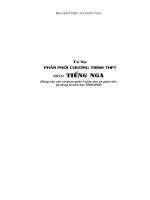Tài liệu Plant protection pptx
Bạn đang xem bản rút gọn của tài liệu. Xem và tải ngay bản đầy đủ của tài liệu tại đây (219.2 KB, 17 trang )
from Asia-Pacific countries
1. Analysis of plant protection information exchange among
APPPC member countries
1.1 BACKGROUND INFORMATION
The development of information technologies has truly changed our lives and the way we
conduct business. In particular, the Internet has made it possible for us to access a wealth
of information at a speed that was unimaginable even a few years ago. Information is power.
Better information enables us to learn from each other, improve the quality of our work and
contribute to better functioning societies and a world community. On the other hand, we
have more information than we can possibly absorb, which makes it necessary for us to
organize the information in such a way that it can be more easily accessed, understood and
used. In agricultural sciences, this is often done through databases and structured
information sheets such as country profiles.
Providing access to information is an important instrument in the development of
agriculture. For example, FAO maintains about 35 databases, some of which also publish
their own specific country profiles such as for livestock, fisheries, forestry, land and water
use, pastures, food security, biotechnology, food safety, and animal and plant health.
However, there is no database or country profiles for plant protection. There exists the
International Phytosanitary Portal (IPP) for country phytosanitary information; however, the
unstructured format of the posted information makes it difficult to compile and compare the
information in a systematic manner. No unified source of information exists for other plant
protection areas such as pest and pesticide management, or the control of pest outbreaks.
Some data can be found in conference proceedings or on websites of country plant
protection organizations. However, this information is difficult to find and to compile since it
is often incomplete or only available in the local language.
Many international conventions require their members to report regularly on the status of
implementation. For example, the International Plant Protection Convention (IPPC) requires
its member countries to exchange phytosanitary information relevant to international trade.
In addition, under the revised text of the IPPC, governments are encouraged to report on
regular pest surveillance and monitoring, the establishment and maintenance of pest-free
areas, and the results of pest risk analyses that they have conducted. The World Trade
Organization (WTO) requires countries to report on phytosanitary trade restrictions, and the
Rotterdam Convention collects country information on the implementation of the Prior
Informed Consent (PIC) procedure. Similarly, the International Code of Conduct on the
Distribution and Use of Pesticides was recently amended to include a provision to monitor
and report on the implementation of the Code. However, no reporting procedures have yet
been set up.
The availability of country plant protection profiles would facilitate the international
reporting requirements, and - in addition - could help formulate better strategies and
policies, provide an early warning of dangerous trends, and assist in regional harmonization
and cooperation by providing transparency of procedures and practices. However, to be
useful, country profiles should provide key information in an organized and structured
manner so that it can be easily understood and updated. By following a standard format and
using same measurement units, it would become easy to find, compile and compare country
plant protection information. This would also be an important step towards indicators for the
development of the different plant protection fields which could be published as part of
“Selected Indicators of Food and Agricultural Development in Asia-Pacific Region”
1
.
The Asia and Pacific Plant Protection Commission (APPPC) has recognized the importance
of efficient and transparent exchange of critical information as an important means to
improve regional cooperation and development. It is also aware that the need for accurate
and structured information will increase in the coming years. Therefore, the development of
country profiles on plant protection information is seen as an important means to improve
the exchange of information among member countries.
The 24 member states (see Figure 1) of APPPC vary greatly in size and level of economic
development. The association includes all countries of the region except Bhutan, Brunei,
East Timor, Japan, Maldives, Mongolia, Singapore and several Pacific island states. Biennial
meetings are convened to review the activities carried out by the Commission in the
previous two years and to review the overall plant protection situation at national and
regional levels. For that purpose, country reports are presented at the meetings following a
set of guidelines.
Figure 1. Member States of the Asia and Pacific Plant Protection Commission (APPPC)
APPPC was founded in 1956. An amendment to the original agreement related to the
financing of the activities of the Commission was adopted in 1983, but has not yet entered
into force because the number of the accepting countries has not reached the required two-
thirds of the countries. A revised Plant Protection Agreement for Asia and the Pacific region
was approved in 1999, but it is still pending until two-thirds of the member countries accept
the revision.
All APPPC members also belong to the International Plant Protection Convention (IPPC),
while Japan belongs to IPPC but not to APPPC.
APPPC members and Japan also belong to other international conventions and agreements
that aim to provide universally accepted standards for agricultural production and food
products in order to protect consumers and the environment, and practice fair trade. All
countries have signed on to the Codex Alimentarius and the Convention on Biological
Diversity (CBD), and most countries are members or are in the process of becoming
members of the World Trade Organization (WTO). However, three international agreements
on pesticides (Rotterdam, Stockholm and Basel) have only been ratified by 15-20 countries,
depending on the updated data.
Figure 2. Ratification and membership of international agreements
The range of traditional plant protection functions as shown in Figure 3 covers general crop
pest management, the control of invasive or migratory pests, plant quarantine and pesticide
management. APPPC’s country report guidelines cover these four major areas under the
headings of “Outbreaks of Major Pests”, “Integrated Pest Management”, “Plant Quarantine”
and “Pesticides”.
APPPC and IPPC assume member countries to have national plant protection organizations.
Under the IPPC definition, the official National Plant Protection Organization (NPPO) is the
government service that discharges the functions specified by IPPC. Table 1 shows that
these functions do not include the areas of IPM and pesticide management but define the
official NPPO as the nationalauthority for the “control and issuance of phytosanitary
certificates”
2
. In some countries, this is the responsibility of the national plant protection
service, in other countries it is handled by a specialized unit. While IPPC is primarily
concerned about the transboundary movement of pests, APPPC addresses the full range of
plant protection functions. These different perspectives affect the reporting and exchange of
information.
Figure 3. Plant protection functions
In recent years, increasing emphasis was placed on plant quarantine which is also reflected
in the importance of phytosanitary measures to regulate the import and export of food under
the WTO-SPS Agreement. This agreement allows countries to set their own standards to the
extent necessary to protect human, animal or plant life or health. It stipulates that
regulations must be based on science and should not be applied arbitrarily or as trade
barriers. However, despite the increasing importance of plant quarantine under WTO-SPS,
only four NPPO are the official National Enquiry Point for WTO-SPS. In six countries, the
WTO-SPS enquiry points are not even part of the Ministry of Agriculture (Figure 4).
The actual organizational arrangements to execute the various plant protection functions
differ greatly from country to country and have changed over the years. Among the meeting
participants, only 7 countries have a single national plant protection organization that is
responsible for the full range of plant protection functions (Figure 4). In the majority of
countries (14), pesticide management has been moved to a separate organizational unit
(mostly still within Ministry of Agriculture). The core plant protection functions of pest
management and plant quarantine are executed by separate organizations in at least 8
countries. Some countries have even created specialized and sometimes independent units
for IPM or pest risk assessments.
Table 1. Comparison of member functions under APPPC and IPPC
APPPC
Article IV, revised agreement 1999
IPPC
Article IV, revised text 1997
NPPO-Functions
Phytosanitary measures
Review state of plant protection in the region
and need for action (b)
Promotion of appropriate measures to prevent
introduction and spread of pests (c)
Inspection of consignments for international
traffic
(2c)
Disinfestation or disinfection of international
consignments (2d)
Promote application of phytosanitary
Issuance of phytosanitary certificates (2a)
Ensure post-certification phytosanitary
security prior to export (2g)
Regional standards for the development of
pest risk analysis (d)
Conduct pest risk analysis (2f)
Surveillance
Regional standards for the identification of
pests for common action (d)
Inspections of plants with the object of
reporting existence, outbreaks and spread of
plant pests and of controlling those pests (2b)
Pest Free Area Management
Regional standards for the recognition of
pest-free areas (d)
Promoting establishment of pest free areas (c)
Protection of endangered areas and the
designation, maintenance and surveillance of
pest free areas and areas of low pest
prevalence (2e)
Staff Training
Coordination and arrangements for training (i) Staff training and development (2h)
Additional Party Provisions
Information Exchange
Collection, collation and dissemination of
plant protection information (h)
Exchange information regarding regulated
pests and their control (3a)
Phytosanitary Standards and Regulations
Develop and adopt regional Standards (d)
Provide assistance to develop ISPM (e)
Promoting multi- and bilateral agreements (j)
Issue phytosanitary regulations (3c)
Plant Protection Research
Research and investigations in the field of
plant protection (3b)
(Integrated) Pest Management
Promoting appropriate measures to control
pests, incl. use of IPM (c)
Review status of and promote IPM (f)
Not a function
Pesticide Management
Harmonize pesticide regulations (g) Not a function
In an increasing number of countries, plant protection functions are executed by a network
of different plant protection organizations, like in Australia, China, Japan, Republic of Korea,
New Zealand and Thailand.
The organizational diversity of plant protection was also reflected in the range of
institutional affiliation of participants who attended the 24
th
APPPC Session in 2005. They
came from general plant protection (14)
3
, plant quarantine (20), pesticide management (5),
extension (9), research (13), biosecurity (4) and others (9).
Figure 4. Range of plant protection responsibilities of the Official NPPO (preliminary data)
The responsibilities of national plant protection organizations are also affected by
international developments in biosecurity in food and agriculture. In the broadest sense,
biosecurity attempts to ensure that ecologies sustain people and animals through
biodiversity and prevention of diseases. FA O
4
defined biosecurity as the management of all
biological and environmental risks associated with food and agriculture, which covers
biosafety, food safety and plant as well as animal health. Biosafety under the Cartagena
protocol deals with the safe transfer, handling and use of living modified organisms (LMOs).
Thus, the contributions of plant protection to biosecurity are more than phytosanitary
measures to reduce the risks of introduction of plant pests.
1.2 ANALYSIS OF THE 2005 APPPC COUNTRY REPORTS
The 24
th
Session of APPPC in 2005 was attended by delegates from 20 member states plus
Japan as an observer. Absent were France (for French Polynesia), Papua New Guinea,
Western Samoa and Solomon Islands. All country delegations presented country reports,
which were analyzed to order to assess the reporting mechanisms with regard to the status
of the plant protection situation in the region
5
.









